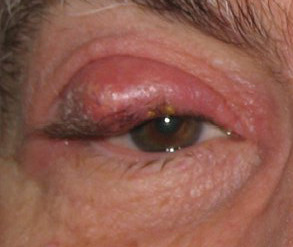Chalazion
| Chalazion | |
|---|---|
| Synonyms | meibomian gland lipogranuloma |
 |
|
| Eyelid affected by chalazion | |
| Pronunciation | |
| Classification and external resources | |
| Specialty | Ophthalmology |
| ICD-10 | H00.1 |
| ICD-9-CM | 373.2 |
| DiseasesDB | 6009 |
| MedlinePlus | 001006 |
| eMedicine | emerg/94 oph/243 |
| Patient UK | Chalazion |
| MeSH | D017043 |
Chalazion is a cyst in the eyelid due to a blocked oil gland. They are typically in the middle of the eyelid, red, and non painful. They tend to come on gradually over a few weeks.
A chalazion may occur following a stye or from hardened oils blocking the gland. The blocked gland is usually the meibomian gland but can also be the gland of Zeis. A stye and cellulitis may appear similar. A stye; however, is usually more sudden in onset, painful, and occurs at the edge of the eyelid. Cellulitis is also typically painful.
Treatment is typically initially with warm compresses. If this is not effective injecting steroids into the lesion may be tried. If large, incision and drainage may be recommended. While relatively common the frequency of the condition is unknown. The term is from the Greek "khalazion" meaning "small hailstone".
A chalazion or meibomian cyst can sometimes be mistaken for a stye.
Topical antibiotic eye drops or ointment (e.g., chloramphenicol or fusidic acid) are sometimes used for the initial acute infection, but are otherwise of little value in treating a chalazion. Chalazia will often disappear without further treatment within a few months, and virtually all will reabsorb within two years. Healing can be facilitated by applying a warm compress to the affected eye for approximately 15 minutes 4 times per day. This promotes drainage and healing by softening the hardened oil that is occluding the duct.
If they continue to enlarge or fail to settle within a few months, smaller lesions may be injected with a corticosteroid, or larger ones may be surgically removed using local anesthesia. This is usually done from underneath the eyelid to avoid a scar on the skin. If the chalazion is located directly under the eyelid's outer tissue, however, an excision from above may be more advisable so as not to inflict any unnecessary damage on the lid itself. Eyelid epidermis usually mends well, without leaving any visible scar. Depending on the chalazion's texture, the excision procedure varies: while fluid matter can easily be removed under minimal invasion, by merely puncturing the chalazion and exerting pressure upon the surrounding tissue, hardened matter usually necessitates a larger incision, through which it can be scraped out. Any residual matter should be metabolized in the course of the subsequent healing process, generally aided by regular appliance of dry heat. The excision of larger chalazia may result in visible hematoma around the lid, which will wear off within three or four days, whereas the swelling may persist for longer. Chalazion excision is an ambulant treatment and normally does not take longer than fifteen minutes. Nevertheless, owing to the risks of infection and severe damage to the eyelid, such procedures should only be performed by a medical professional.
...
Wikipedia
